

CPU核心中idle进程作用
描述
cpuidle framework
每一个 CPU 核心都会有一个 idle 进程,idle 进程是当系统没有调度 CPU 资源的时候,会进入 idle 进程,而 idle 进程的作用就是不使用 CPU,以此达到省电的目的。
在ARM64架构中,当CPU Idle时,会调用WFI指令(wait for interrupt),关掉CPU的Clock以便降低功耗,当有外设中断触发时,CPU又会恢复回来。
cpuidle core 是 cpuidle framework 的核心模块,负责抽象出 cpuidle device、cpuidle driver 和 cpuidle governor 三个实体,如下所示:
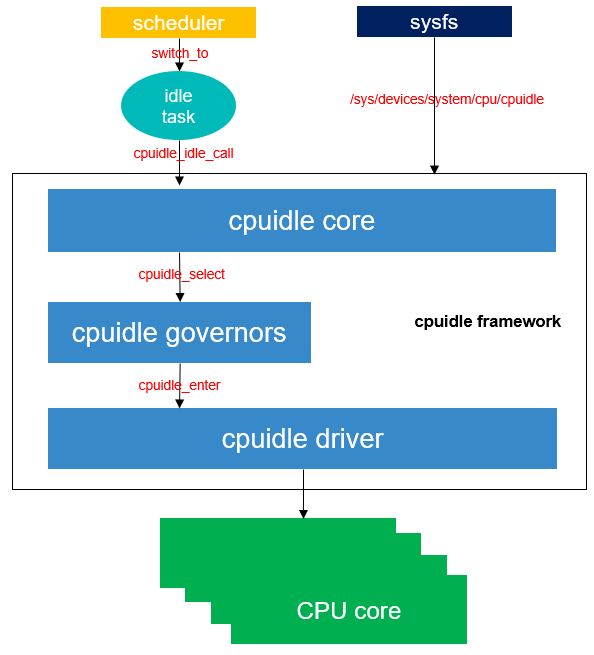
cpuidle core 抽象出了 cpuidle device、cpuidle driver 和 cpuidle governor 三个数据结构。
数据结构
cpuidle_device
针对每个CPU核都对应一个struct cpuidle_device结构,主要字段介绍如下
struct cpuidle_device {
//该cpu核是否注册进内核中
unsigned int registered:1;
//该cpu核是否已经使能
unsigned int enabled:1;
unsigned int use_deepest_state:1;
//对应的cpu number
unsigned int cpu;
//该cpu核上一次停留在cpuidle状态的时间(us)
int last_residency;
//记录每个cpuidle状态的统计信息,包括是否使能、进入该cpuidle状态的次数,停留在该cpuidle状态的总时间(us)
struct cpuidle_state_usage states_usage[CPUIDLE_STATE_MAX];
......
};
对应的注册接口是 cpuidle_register_device。
cpuidle_driver
cpuidle driver用于驱动一个或多个CPU核,关键字段描述如下:
struct cpuidle_driver {
const char *name;
struct module *owner;
int refcnt;
//用于驱动注册时判断是否需要设置broadcast timer
unsigned int bctimer:1;
//用于描述cpuidle的状态,需要按照功耗从大到小来排序,具体有多少个cpuidle状态
struct cpuidle_state states[CPUIDLE_STATE_MAX];
......
};
//CPU有多种不同的idle级别。这些idle级别有不同的功耗和延迟,从而可以在不同的场景下使用
//主要包括exit_latency、power_usage、target_residency。这些特性是governor制定idle策略的依据
struct cpuidle_state {
char name[CPUIDLE_NAME_LEN];
char desc[CPUIDLE_DESC_LEN];
unsigned int flags;
//CPU从该idle state下返回运行状态的延迟,单位为us。它决定了CPU在idle状态和run状态之间切换的效率,如果延迟过大,将会影响系统性能;
unsigned int exit_latency; /* in US */
//CPU在该idle state下的功耗,单位为mW
int power_usage; /* in mW */
//期望的停留时间,单位为us。进入和退出idle state是需要消耗额外的能量的,如果在idle状态停留的时间过短,节省的功耗少于额外的消耗,则得不偿失。governor会根据该字段,结合当前的系统情况(如可以idle多久),选择idle level;
unsigned int target_residency; /* in US */
bool disabled; /* disabled on all CPUs */
//进入该state的回调函数
int (*enter) (struct cpuidle_device *dev,
struct cpuidle_driver *drv,
int index);
//CPU长时间不需要工作时(称作offline),可调用该回调函数。
int (*enter_dead) (struct cpuidle_device *dev, int index);
......
};
对应的注册接口是 cpuidle_register_driver。
cpuidle_governor
governor 结构主要提供不同的回调函数,最终由 menu_governor 填充,主要字段如下:
struct cpuidle_governor {
char name[CPUIDLE_NAME_LEN];
struct list_head governor_list;
//governor的级别,正常情况下,kernel会选择系统中rating值最大的governor作为当前governor
unsigned int rating;
//在设备驱动注册和注销的时候调用
int (*enable) (struct cpuidle_driver *drv,
struct cpuidle_device *dev);
void (*disable) (struct cpuidle_driver *drv,
struct cpuidle_device *dev);
//根据当前系统的运行状况,以及各个idle state的特性,选择一个state(即决策)
int (*select) (struct cpuidle_driver *drv,
struct cpuidle_device *dev,
bool *stop_tick);
//通过该回调函数,可以告知governor,系统上一次所处的idle state是哪个
void (*reflect) (struct cpuidle_device *dev, int index);
};
对应的注册接口是 cpuidle_register_governor。
流程
我们先看下设备和驱动的注册过程:
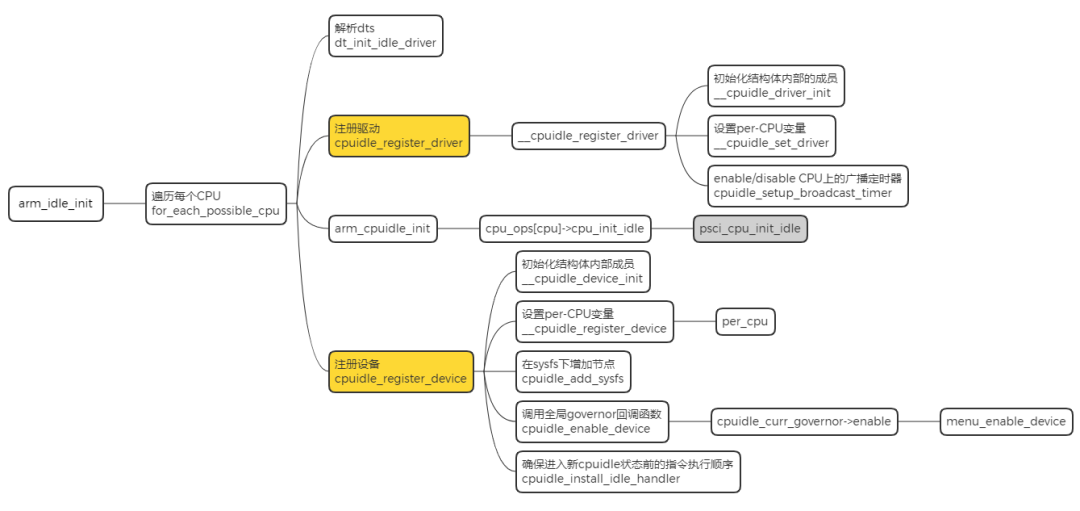
注册之后便将设备和驱动建立起连接关系了,最终 cpuidle framework 的用户便可通过接口来调用下层的接口,进而完成具体的硬件操作。
下面看下 CPU 进入 idle 状态的流程图:
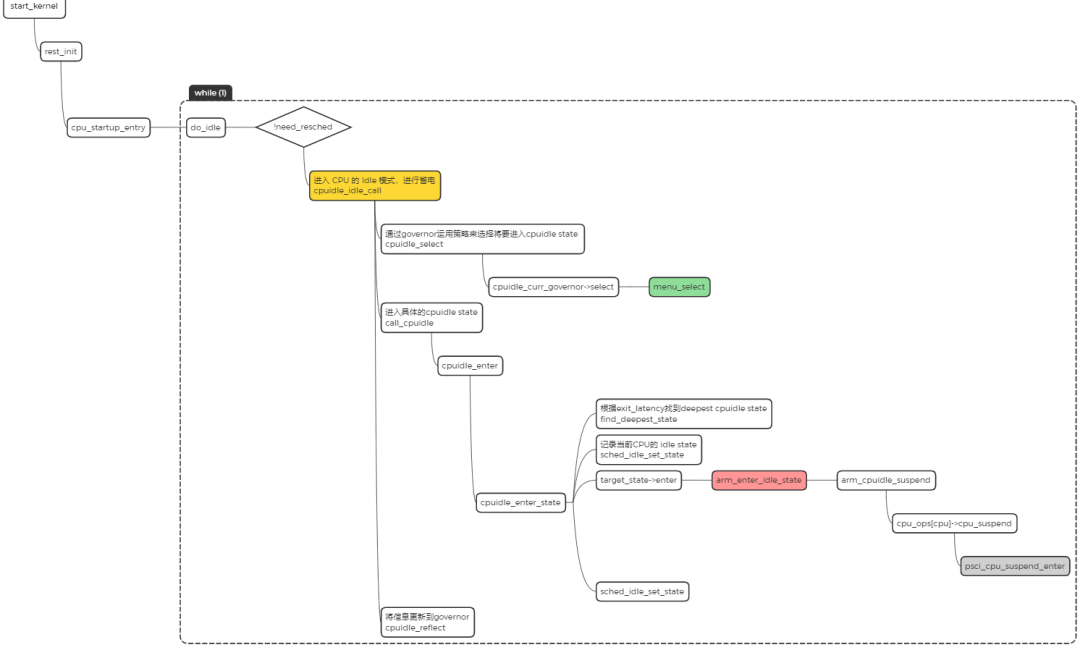
可以看出,最终是通过 PSCI 来实现 CPU 的 suspend。
PSCI
PSCI, Power State Coordination Interface,由ARM定义的电源管理接口规范,通常由Firmware来实现,而Linux系统可以通过smc/hvc指令来进入不同的Exception Level,进而调用对应的实现。
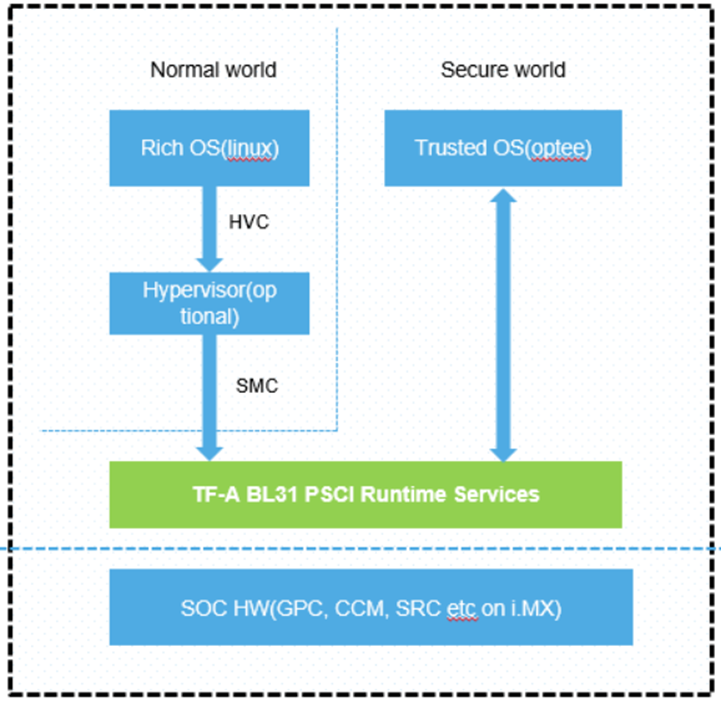
PSCI 支持如下功能:
CPU hotplug (on/off)
CPU idle (suspend/resume)
System suspend/resume
System shutdown and reset
每个功能和ATF之间的调用接口如下所示:
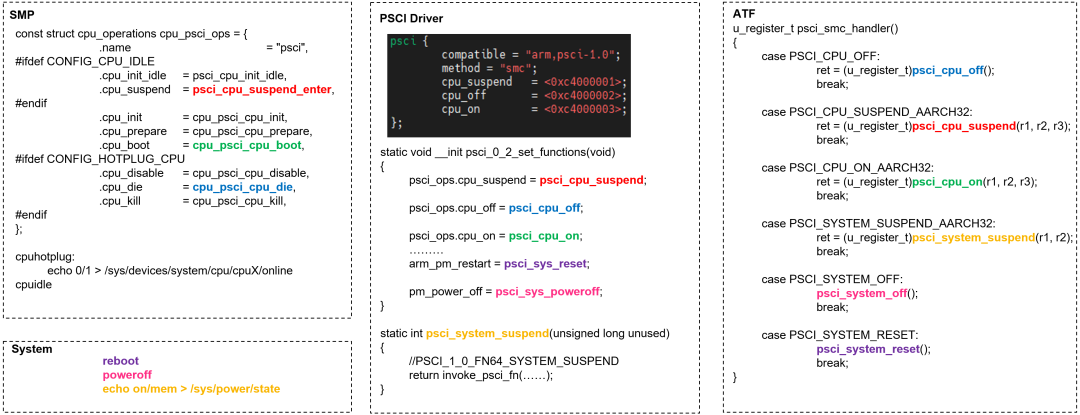
-
Linux进程怎么绑定CPU2022-10-26 2346
-
电源管理入门-CPU Idle有什么用?Idle状态判断2023-11-16 11807
-
【资料共享】Linux Kernel 核心中文手册2015-09-09 2978
-
【Nanopi2试用体验】高级(十):进程绑定CPU核心2016-02-03 3955
-
进程和线程区别2016-11-30 4512
-
线程与6个arm核心中的一个绑定请问如何解绑?2022-09-07 2755
-
什么是CPU核心2009-12-17 1608
-
CPU缓存是什么意思_CPU缓存有什么作用2020-05-19 8484
-
基于linux eBPF的进程off-cpu的方法2020-09-25 3767
-
把进程绑定到某个 CPU 上运行是怎么实现?2021-07-02 3121
-
讲讲线程、进程和CPU中的超线程2022-08-05 3403
-
CPU进入idle进程状态的流程2022-10-14 3422
-
python自带的idle怎么进入2023-11-29 3425
-
kernel到android核心启动过程2023-12-04 1942
-
如何在内核中启动secondary cpu2023-12-05 1164
全部0条评论

快来发表一下你的评论吧 !

